CGE17105 Personal Financial Plan: Cheung Family - UOW College HK
VerifiedAdded on 2023/05/31
|17
|2240
|199
Report
AI Summary
This report provides a comprehensive financial plan for Stephen and Linda Cheung, a couple with two young children, outlining strategies for managing their income, expenses, and investments over the next 18 years until their children attend college. The plan considers their current income from Stephen's IT contracts and Linda's teaching job, alongside their annual living expenses and expected inflation. It includes a loan repayment schedule for property improvements and emphasizes long-term savings through a recurring deposit account with a 12% annual return. The plan recommends investing 80% of their annual surplus in this account to secure funds for their children's education and their own retirement, while also addressing risk tolerance and liquidity considerations. The report concludes with recommendations for loan management and investment strategies to achieve their financial goals.
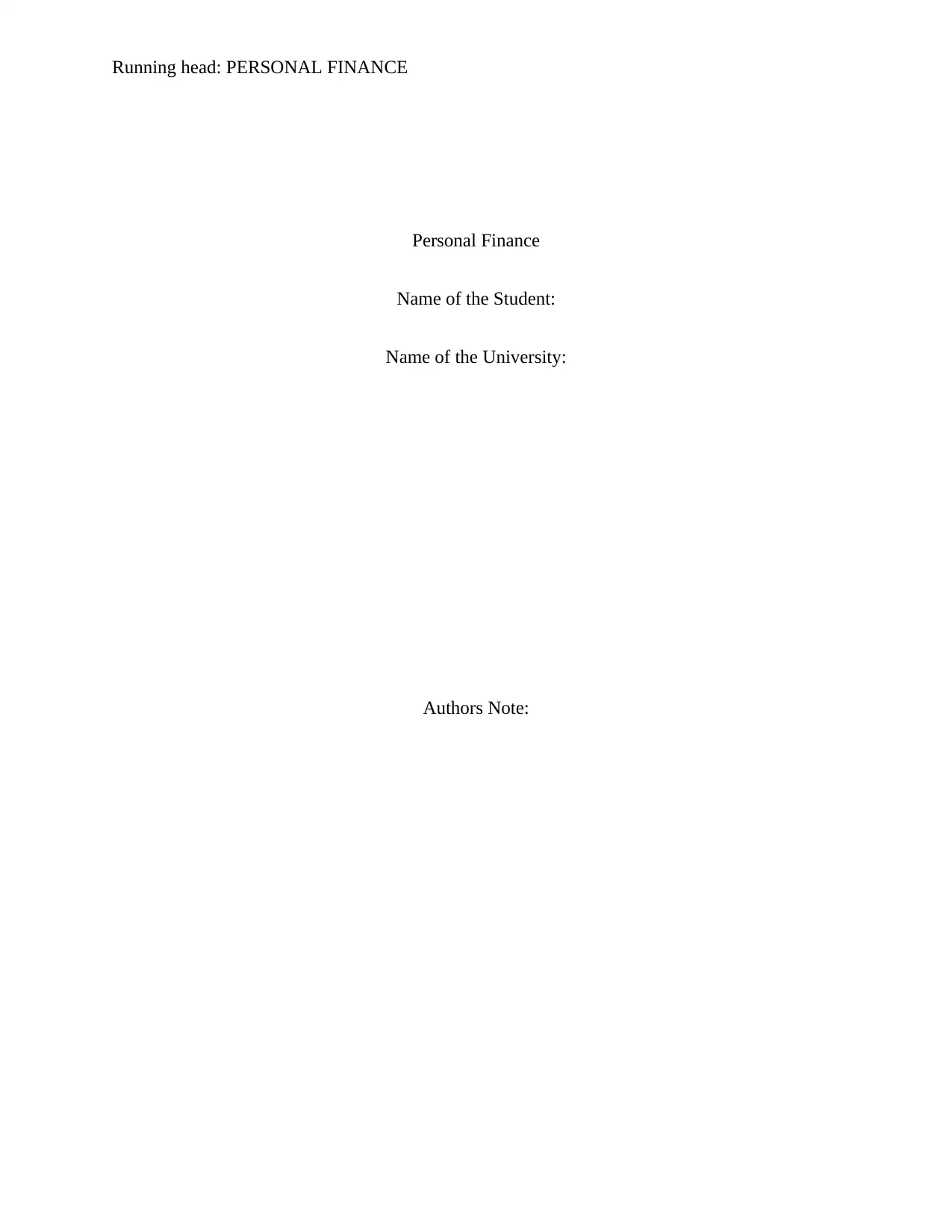
Running head: PERSONAL FINANCE
Personal Finance
Name of the Student:
Name of the University:
Authors Note:
Personal Finance
Name of the Student:
Name of the University:
Authors Note:
Paraphrase This Document
Need a fresh take? Get an instant paraphrase of this document with our AI Paraphraser
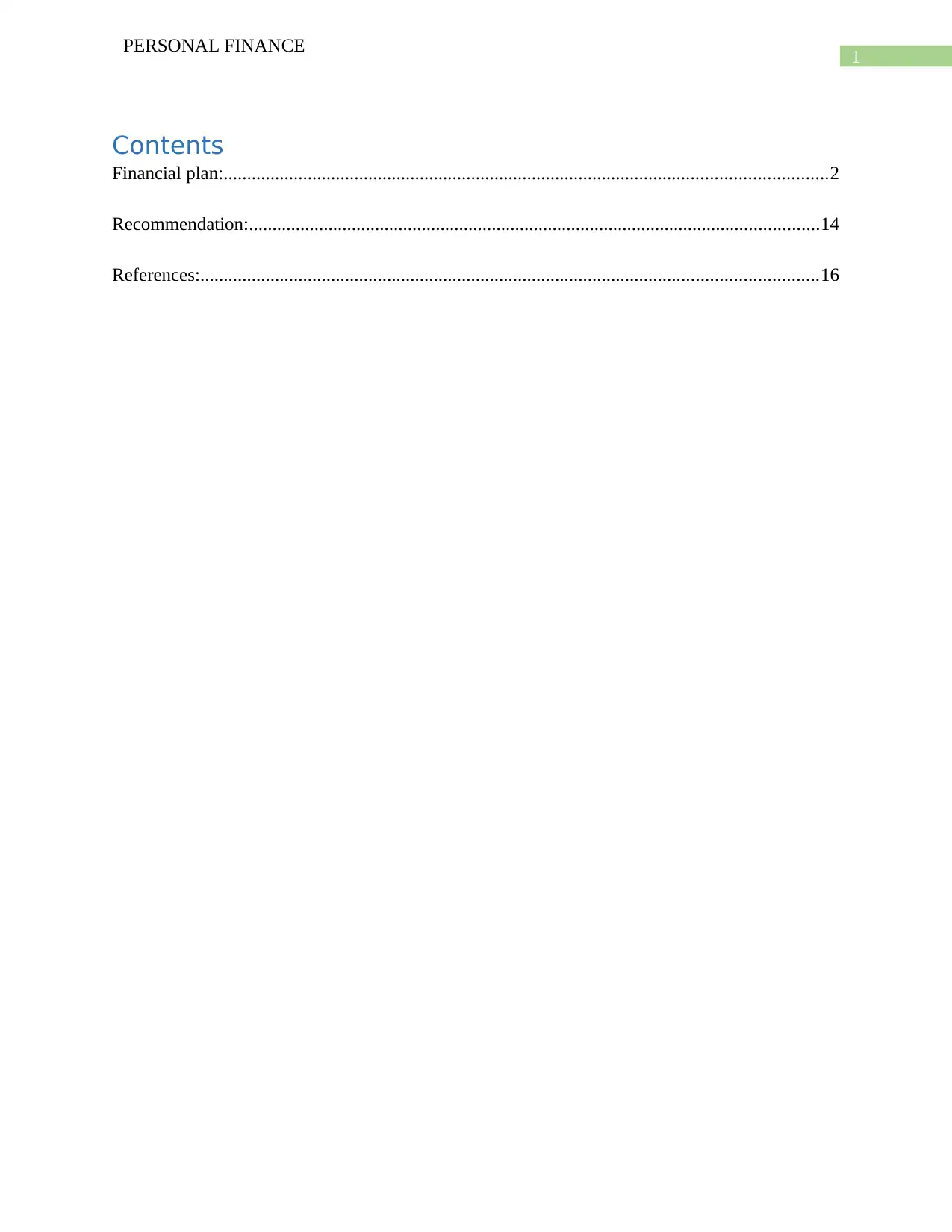
1
PERSONAL FINANCE
Contents
Financial plan:.................................................................................................................................2
Recommendation:..........................................................................................................................14
References:....................................................................................................................................16
PERSONAL FINANCE
Contents
Financial plan:.................................................................................................................................2
Recommendation:..........................................................................................................................14
References:....................................................................................................................................16
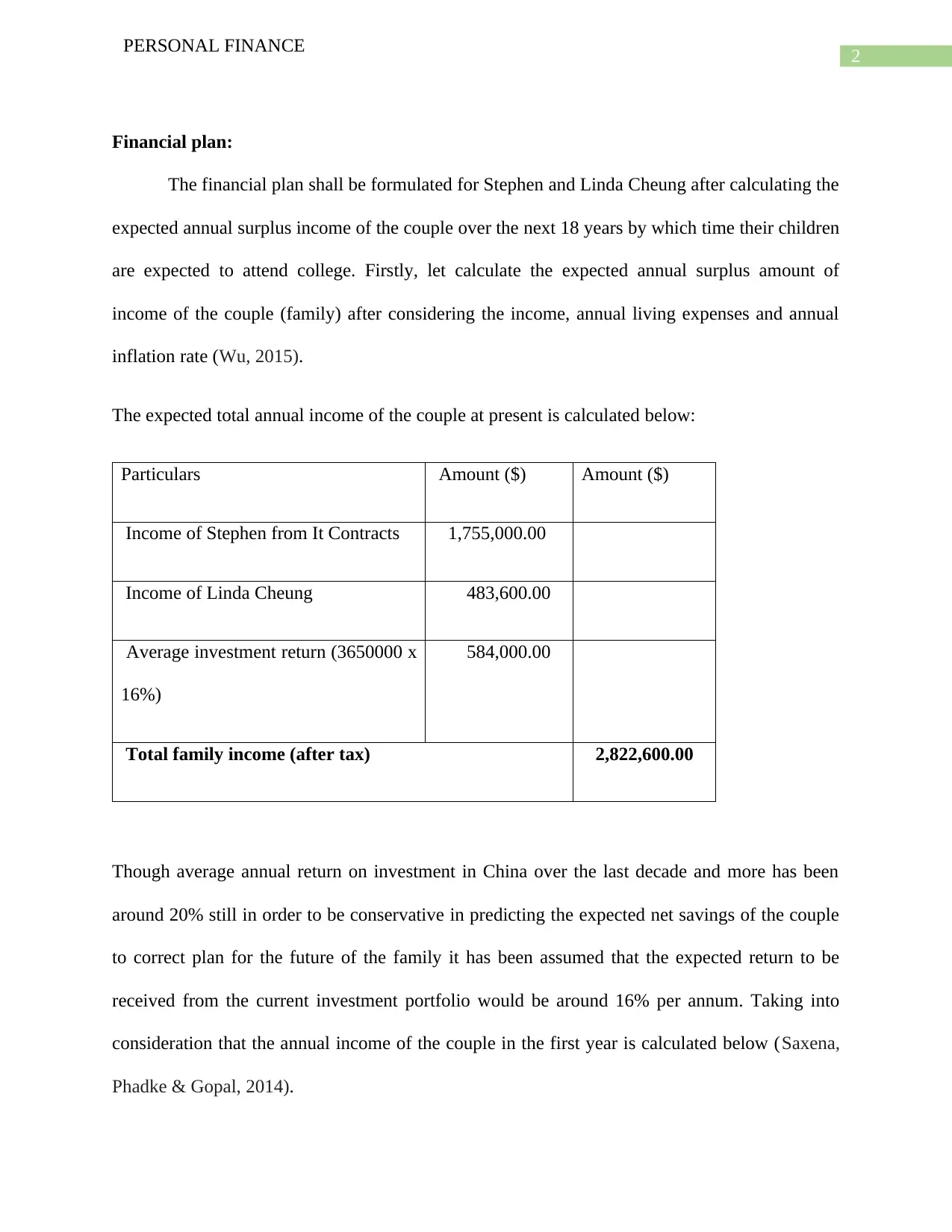
2
PERSONAL FINANCE
Financial plan:
The financial plan shall be formulated for Stephen and Linda Cheung after calculating the
expected annual surplus income of the couple over the next 18 years by which time their children
are expected to attend college. Firstly, let calculate the expected annual surplus amount of
income of the couple (family) after considering the income, annual living expenses and annual
inflation rate (Wu, 2015).
The expected total annual income of the couple at present is calculated below:
Particulars Amount ($) Amount ($)
Income of Stephen from It Contracts 1,755,000.00
Income of Linda Cheung 483,600.00
Average investment return (3650000 x
16%)
584,000.00
Total family income (after tax) 2,822,600.00
Though average annual return on investment in China over the last decade and more has been
around 20% still in order to be conservative in predicting the expected net savings of the couple
to correct plan for the future of the family it has been assumed that the expected return to be
received from the current investment portfolio would be around 16% per annum. Taking into
consideration that the annual income of the couple in the first year is calculated below (Saxena,
Phadke & Gopal, 2014).
PERSONAL FINANCE
Financial plan:
The financial plan shall be formulated for Stephen and Linda Cheung after calculating the
expected annual surplus income of the couple over the next 18 years by which time their children
are expected to attend college. Firstly, let calculate the expected annual surplus amount of
income of the couple (family) after considering the income, annual living expenses and annual
inflation rate (Wu, 2015).
The expected total annual income of the couple at present is calculated below:
Particulars Amount ($) Amount ($)
Income of Stephen from It Contracts 1,755,000.00
Income of Linda Cheung 483,600.00
Average investment return (3650000 x
16%)
584,000.00
Total family income (after tax) 2,822,600.00
Though average annual return on investment in China over the last decade and more has been
around 20% still in order to be conservative in predicting the expected net savings of the couple
to correct plan for the future of the family it has been assumed that the expected return to be
received from the current investment portfolio would be around 16% per annum. Taking into
consideration that the annual income of the couple in the first year is calculated below (Saxena,
Phadke & Gopal, 2014).
⊘ This is a preview!⊘
Do you want full access?
Subscribe today to unlock all pages.

Trusted by 1+ million students worldwide
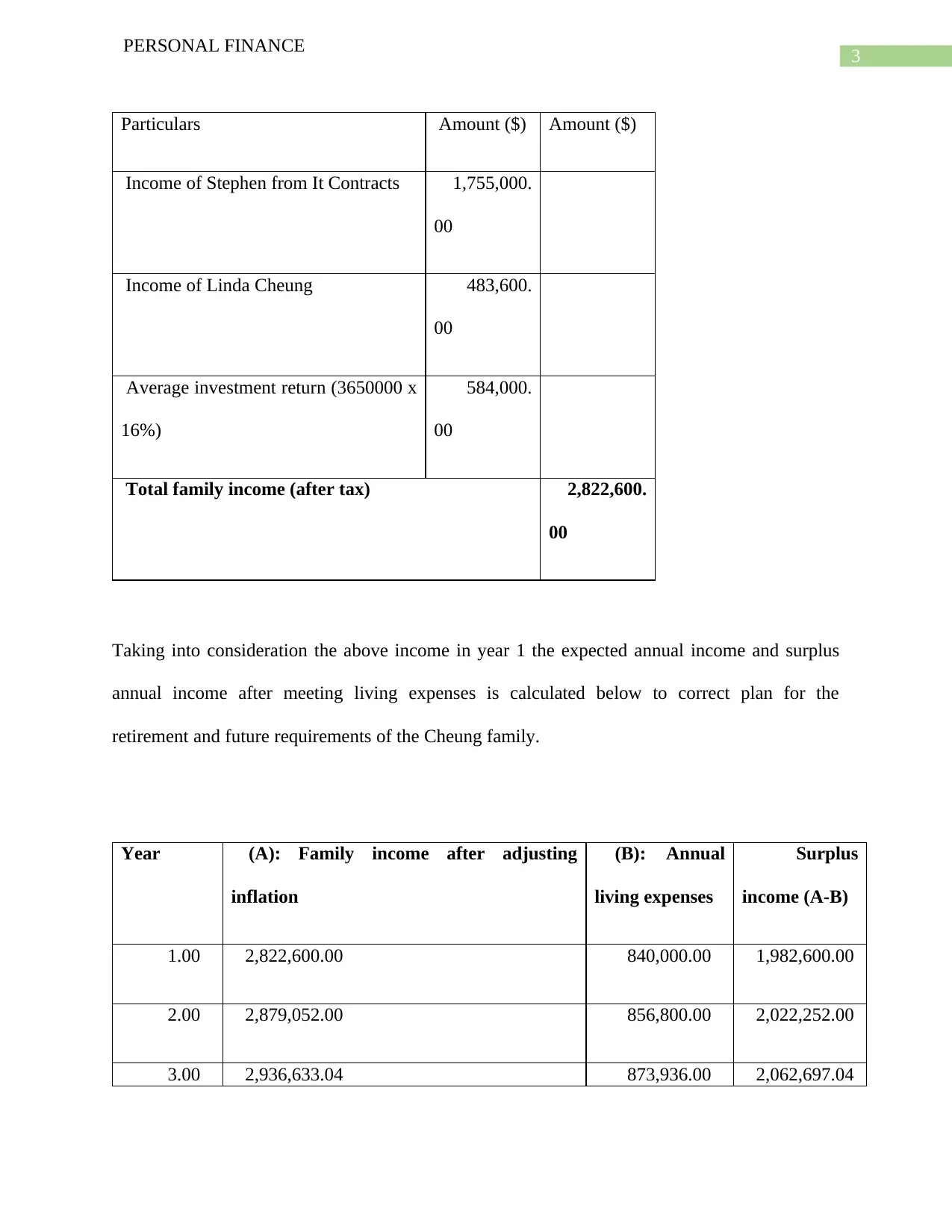
3
PERSONAL FINANCE
Particulars Amount ($) Amount ($)
Income of Stephen from It Contracts 1,755,000.
00
Income of Linda Cheung 483,600.
00
Average investment return (3650000 x
16%)
584,000.
00
Total family income (after tax) 2,822,600.
00
Taking into consideration the above income in year 1 the expected annual income and surplus
annual income after meeting living expenses is calculated below to correct plan for the
retirement and future requirements of the Cheung family.
Year (A): Family income after adjusting
inflation
(B): Annual
living expenses
Surplus
income (A-B)
1.00 2,822,600.00 840,000.00 1,982,600.00
2.00 2,879,052.00 856,800.00 2,022,252.00
3.00 2,936,633.04 873,936.00 2,062,697.04
PERSONAL FINANCE
Particulars Amount ($) Amount ($)
Income of Stephen from It Contracts 1,755,000.
00
Income of Linda Cheung 483,600.
00
Average investment return (3650000 x
16%)
584,000.
00
Total family income (after tax) 2,822,600.
00
Taking into consideration the above income in year 1 the expected annual income and surplus
annual income after meeting living expenses is calculated below to correct plan for the
retirement and future requirements of the Cheung family.
Year (A): Family income after adjusting
inflation
(B): Annual
living expenses
Surplus
income (A-B)
1.00 2,822,600.00 840,000.00 1,982,600.00
2.00 2,879,052.00 856,800.00 2,022,252.00
3.00 2,936,633.04 873,936.00 2,062,697.04
Paraphrase This Document
Need a fresh take? Get an instant paraphrase of this document with our AI Paraphraser
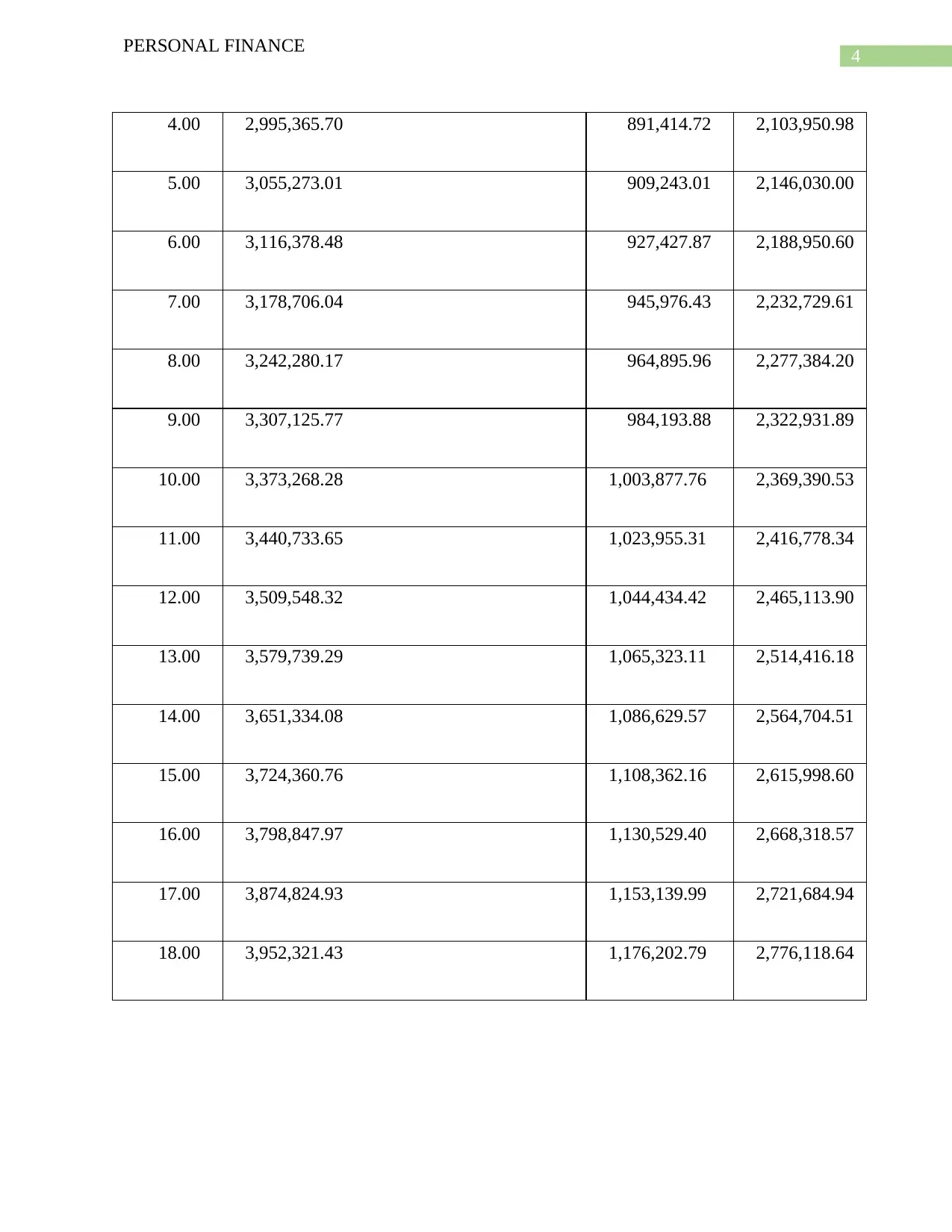
4
PERSONAL FINANCE
4.00 2,995,365.70 891,414.72 2,103,950.98
5.00 3,055,273.01 909,243.01 2,146,030.00
6.00 3,116,378.48 927,427.87 2,188,950.60
7.00 3,178,706.04 945,976.43 2,232,729.61
8.00 3,242,280.17 964,895.96 2,277,384.20
9.00 3,307,125.77 984,193.88 2,322,931.89
10.00 3,373,268.28 1,003,877.76 2,369,390.53
11.00 3,440,733.65 1,023,955.31 2,416,778.34
12.00 3,509,548.32 1,044,434.42 2,465,113.90
13.00 3,579,739.29 1,065,323.11 2,514,416.18
14.00 3,651,334.08 1,086,629.57 2,564,704.51
15.00 3,724,360.76 1,108,362.16 2,615,998.60
16.00 3,798,847.97 1,130,529.40 2,668,318.57
17.00 3,874,824.93 1,153,139.99 2,721,684.94
18.00 3,952,321.43 1,176,202.79 2,776,118.64
PERSONAL FINANCE
4.00 2,995,365.70 891,414.72 2,103,950.98
5.00 3,055,273.01 909,243.01 2,146,030.00
6.00 3,116,378.48 927,427.87 2,188,950.60
7.00 3,178,706.04 945,976.43 2,232,729.61
8.00 3,242,280.17 964,895.96 2,277,384.20
9.00 3,307,125.77 984,193.88 2,322,931.89
10.00 3,373,268.28 1,003,877.76 2,369,390.53
11.00 3,440,733.65 1,023,955.31 2,416,778.34
12.00 3,509,548.32 1,044,434.42 2,465,113.90
13.00 3,579,739.29 1,065,323.11 2,514,416.18
14.00 3,651,334.08 1,086,629.57 2,564,704.51
15.00 3,724,360.76 1,108,362.16 2,615,998.60
16.00 3,798,847.97 1,130,529.40 2,668,318.57
17.00 3,874,824.93 1,153,139.99 2,721,684.94
18.00 3,952,321.43 1,176,202.79 2,776,118.64
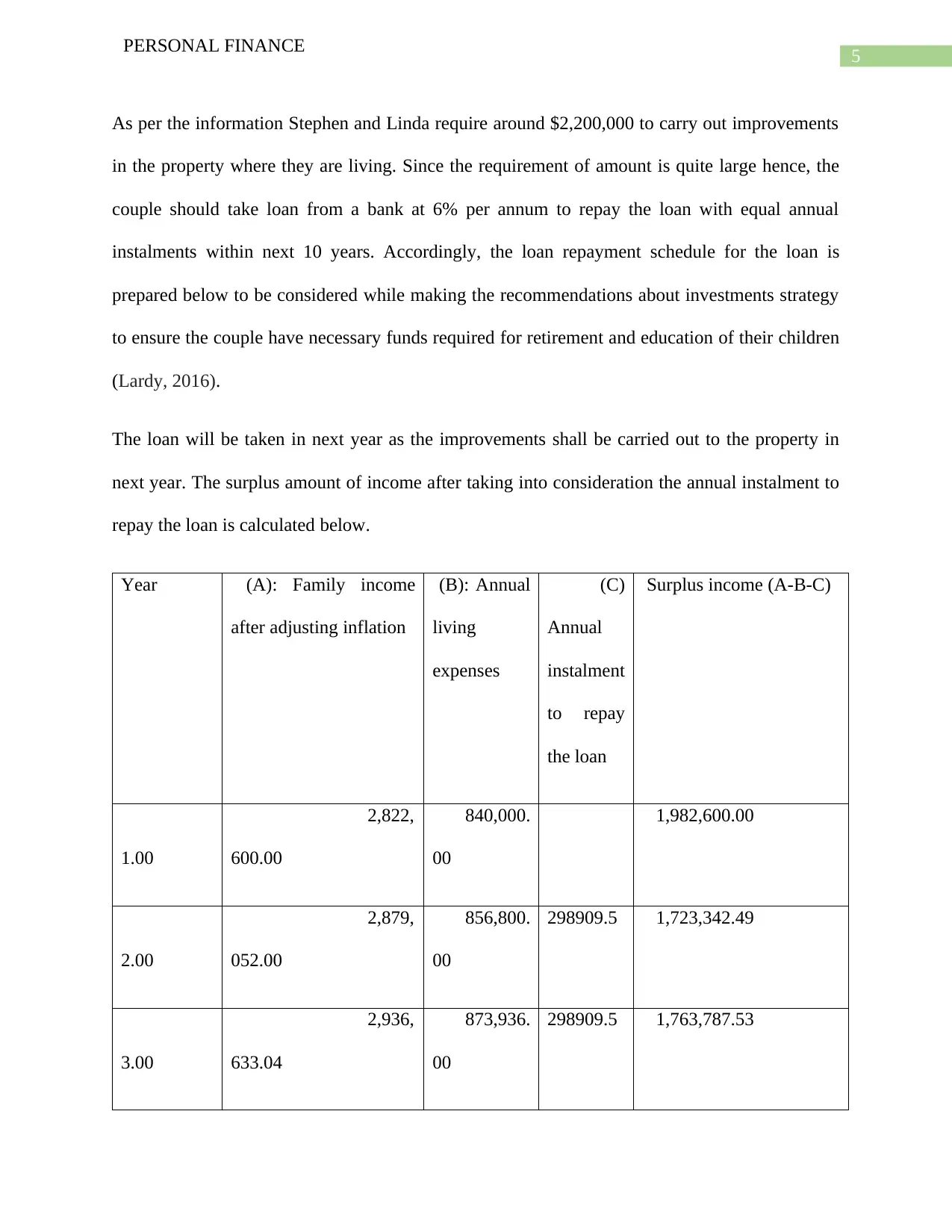
5
PERSONAL FINANCE
As per the information Stephen and Linda require around $2,200,000 to carry out improvements
in the property where they are living. Since the requirement of amount is quite large hence, the
couple should take loan from a bank at 6% per annum to repay the loan with equal annual
instalments within next 10 years. Accordingly, the loan repayment schedule for the loan is
prepared below to be considered while making the recommendations about investments strategy
to ensure the couple have necessary funds required for retirement and education of their children
(Lardy, 2016).
The loan will be taken in next year as the improvements shall be carried out to the property in
next year. The surplus amount of income after taking into consideration the annual instalment to
repay the loan is calculated below.
Year (A): Family income
after adjusting inflation
(B): Annual
living
expenses
(C)
Annual
instalment
to repay
the loan
Surplus income (A-B-C)
1.00
2,822,
600.00
840,000.
00
1,982,600.00
2.00
2,879,
052.00
856,800.
00
298909.5 1,723,342.49
3.00
2,936,
633.04
873,936.
00
298909.5 1,763,787.53
PERSONAL FINANCE
As per the information Stephen and Linda require around $2,200,000 to carry out improvements
in the property where they are living. Since the requirement of amount is quite large hence, the
couple should take loan from a bank at 6% per annum to repay the loan with equal annual
instalments within next 10 years. Accordingly, the loan repayment schedule for the loan is
prepared below to be considered while making the recommendations about investments strategy
to ensure the couple have necessary funds required for retirement and education of their children
(Lardy, 2016).
The loan will be taken in next year as the improvements shall be carried out to the property in
next year. The surplus amount of income after taking into consideration the annual instalment to
repay the loan is calculated below.
Year (A): Family income
after adjusting inflation
(B): Annual
living
expenses
(C)
Annual
instalment
to repay
the loan
Surplus income (A-B-C)
1.00
2,822,
600.00
840,000.
00
1,982,600.00
2.00
2,879,
052.00
856,800.
00
298909.5 1,723,342.49
3.00
2,936,
633.04
873,936.
00
298909.5 1,763,787.53
⊘ This is a preview!⊘
Do you want full access?
Subscribe today to unlock all pages.

Trusted by 1+ million students worldwide
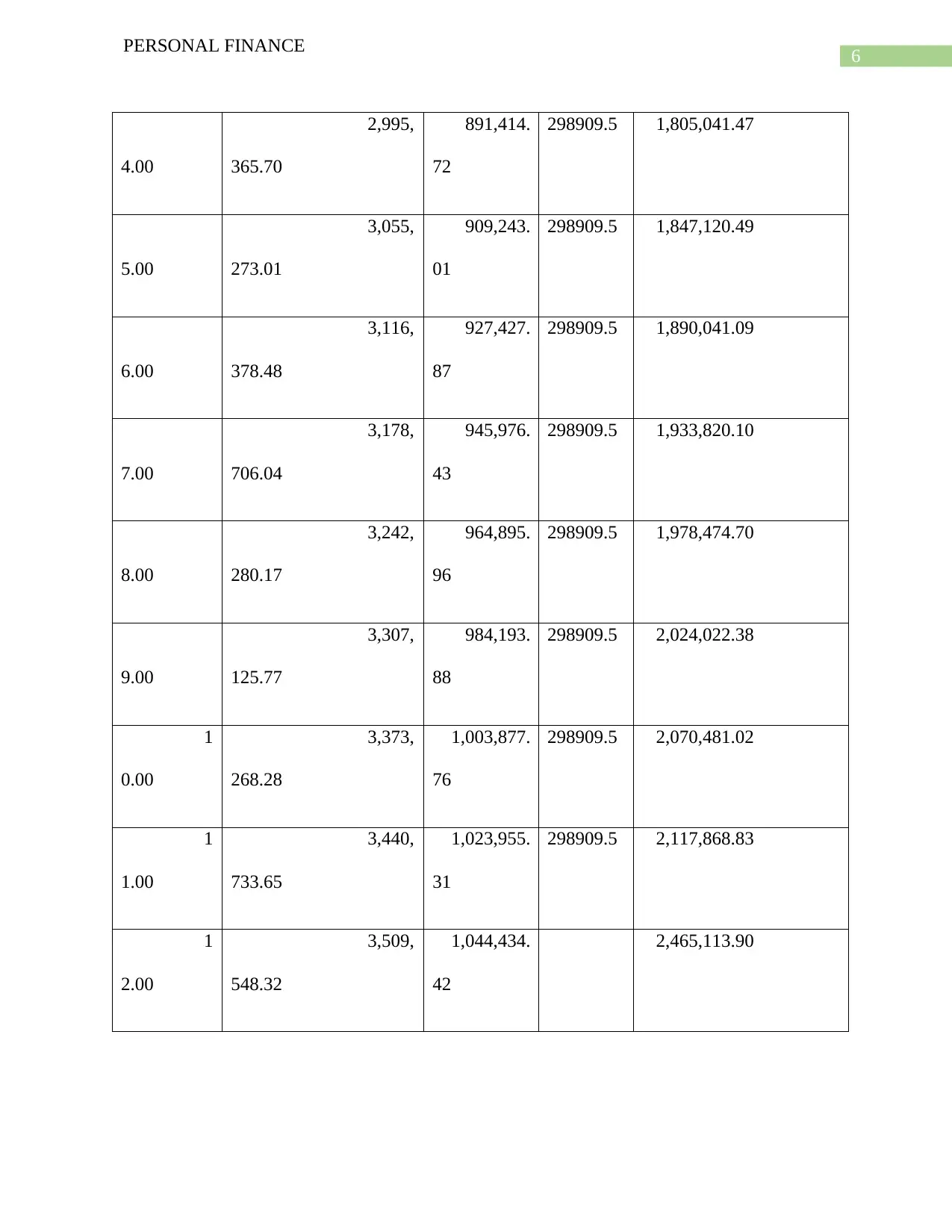
6
PERSONAL FINANCE
4.00
2,995,
365.70
891,414.
72
298909.5 1,805,041.47
5.00
3,055,
273.01
909,243.
01
298909.5 1,847,120.49
6.00
3,116,
378.48
927,427.
87
298909.5 1,890,041.09
7.00
3,178,
706.04
945,976.
43
298909.5 1,933,820.10
8.00
3,242,
280.17
964,895.
96
298909.5 1,978,474.70
9.00
3,307,
125.77
984,193.
88
298909.5 2,024,022.38
1
0.00
3,373,
268.28
1,003,877.
76
298909.5 2,070,481.02
1
1.00
3,440,
733.65
1,023,955.
31
298909.5 2,117,868.83
1
2.00
3,509,
548.32
1,044,434.
42
2,465,113.90
PERSONAL FINANCE
4.00
2,995,
365.70
891,414.
72
298909.5 1,805,041.47
5.00
3,055,
273.01
909,243.
01
298909.5 1,847,120.49
6.00
3,116,
378.48
927,427.
87
298909.5 1,890,041.09
7.00
3,178,
706.04
945,976.
43
298909.5 1,933,820.10
8.00
3,242,
280.17
964,895.
96
298909.5 1,978,474.70
9.00
3,307,
125.77
984,193.
88
298909.5 2,024,022.38
1
0.00
3,373,
268.28
1,003,877.
76
298909.5 2,070,481.02
1
1.00
3,440,
733.65
1,023,955.
31
298909.5 2,117,868.83
1
2.00
3,509,
548.32
1,044,434.
42
2,465,113.90
Paraphrase This Document
Need a fresh take? Get an instant paraphrase of this document with our AI Paraphraser
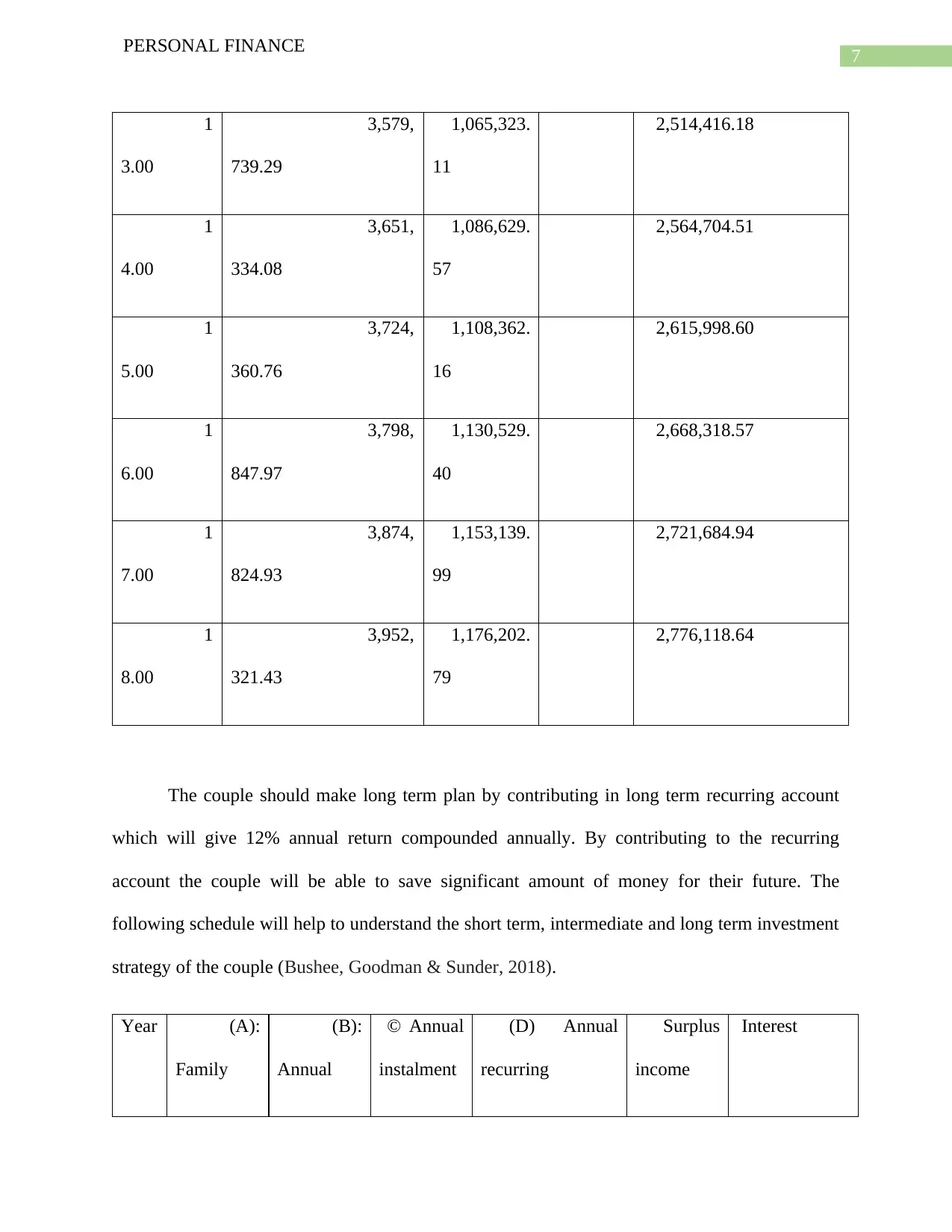
7
PERSONAL FINANCE
1
3.00
3,579,
739.29
1,065,323.
11
2,514,416.18
1
4.00
3,651,
334.08
1,086,629.
57
2,564,704.51
1
5.00
3,724,
360.76
1,108,362.
16
2,615,998.60
1
6.00
3,798,
847.97
1,130,529.
40
2,668,318.57
1
7.00
3,874,
824.93
1,153,139.
99
2,721,684.94
1
8.00
3,952,
321.43
1,176,202.
79
2,776,118.64
The couple should make long term plan by contributing in long term recurring account
which will give 12% annual return compounded annually. By contributing to the recurring
account the couple will be able to save significant amount of money for their future. The
following schedule will help to understand the short term, intermediate and long term investment
strategy of the couple (Bushee, Goodman & Sunder, 2018).
Year (A):
Family
(B):
Annual
© Annual
instalment
(D) Annual
recurring
Surplus
income
Interest
PERSONAL FINANCE
1
3.00
3,579,
739.29
1,065,323.
11
2,514,416.18
1
4.00
3,651,
334.08
1,086,629.
57
2,564,704.51
1
5.00
3,724,
360.76
1,108,362.
16
2,615,998.60
1
6.00
3,798,
847.97
1,130,529.
40
2,668,318.57
1
7.00
3,874,
824.93
1,153,139.
99
2,721,684.94
1
8.00
3,952,
321.43
1,176,202.
79
2,776,118.64
The couple should make long term plan by contributing in long term recurring account
which will give 12% annual return compounded annually. By contributing to the recurring
account the couple will be able to save significant amount of money for their future. The
following schedule will help to understand the short term, intermediate and long term investment
strategy of the couple (Bushee, Goodman & Sunder, 2018).
Year (A):
Family
(B):
Annual
© Annual
instalment
(D) Annual
recurring
Surplus
income
Interest
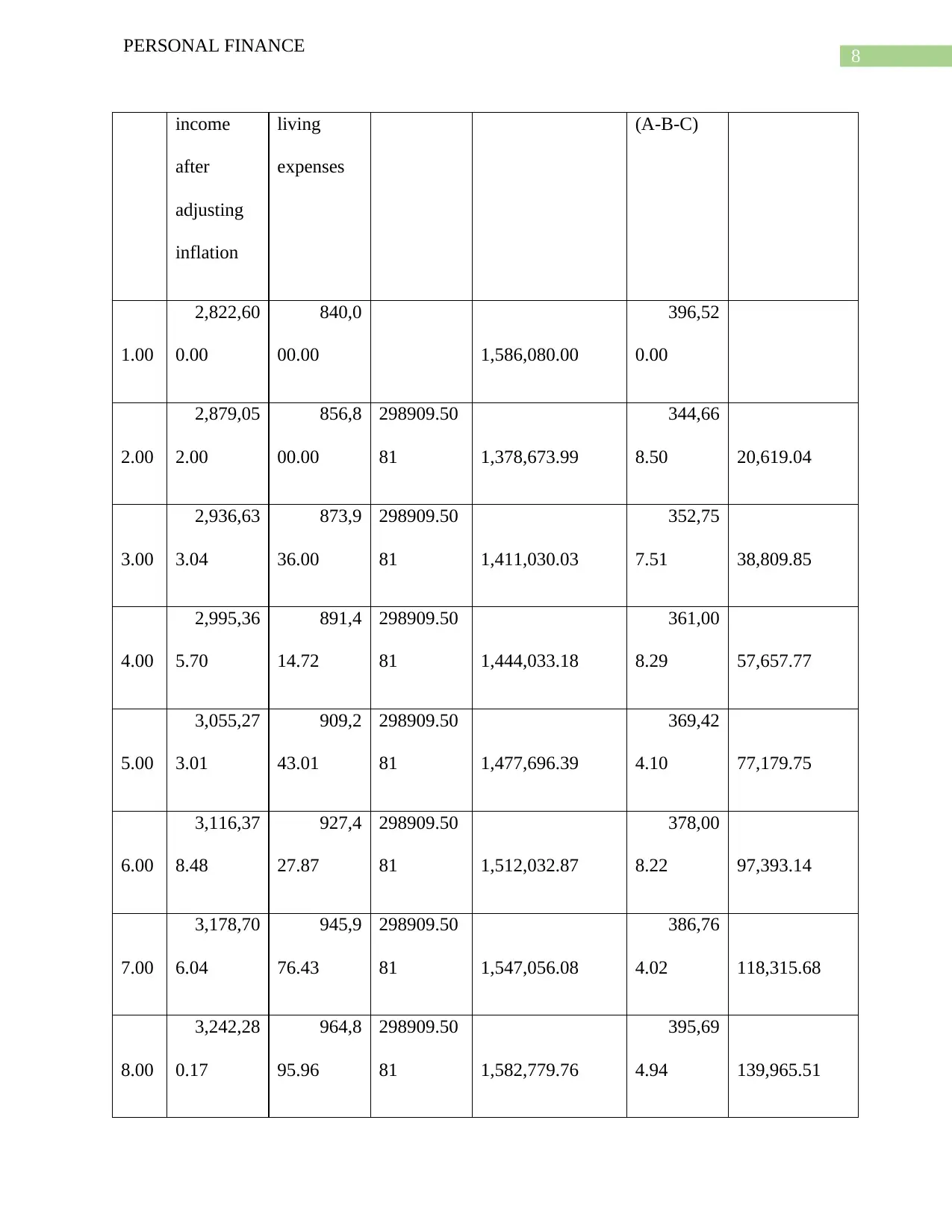
8
PERSONAL FINANCE
income
after
adjusting
inflation
living
expenses
(A-B-C)
1.00
2,822,60
0.00
840,0
00.00 1,586,080.00
396,52
0.00
2.00
2,879,05
2.00
856,8
00.00
298909.50
81 1,378,673.99
344,66
8.50 20,619.04
3.00
2,936,63
3.04
873,9
36.00
298909.50
81 1,411,030.03
352,75
7.51 38,809.85
4.00
2,995,36
5.70
891,4
14.72
298909.50
81 1,444,033.18
361,00
8.29 57,657.77
5.00
3,055,27
3.01
909,2
43.01
298909.50
81 1,477,696.39
369,42
4.10 77,179.75
6.00
3,116,37
8.48
927,4
27.87
298909.50
81 1,512,032.87
378,00
8.22 97,393.14
7.00
3,178,70
6.04
945,9
76.43
298909.50
81 1,547,056.08
386,76
4.02 118,315.68
8.00
3,242,28
0.17
964,8
95.96
298909.50
81 1,582,779.76
395,69
4.94 139,965.51
PERSONAL FINANCE
income
after
adjusting
inflation
living
expenses
(A-B-C)
1.00
2,822,60
0.00
840,0
00.00 1,586,080.00
396,52
0.00
2.00
2,879,05
2.00
856,8
00.00
298909.50
81 1,378,673.99
344,66
8.50 20,619.04
3.00
2,936,63
3.04
873,9
36.00
298909.50
81 1,411,030.03
352,75
7.51 38,809.85
4.00
2,995,36
5.70
891,4
14.72
298909.50
81 1,444,033.18
361,00
8.29 57,657.77
5.00
3,055,27
3.01
909,2
43.01
298909.50
81 1,477,696.39
369,42
4.10 77,179.75
6.00
3,116,37
8.48
927,4
27.87
298909.50
81 1,512,032.87
378,00
8.22 97,393.14
7.00
3,178,70
6.04
945,9
76.43
298909.50
81 1,547,056.08
386,76
4.02 118,315.68
8.00
3,242,28
0.17
964,8
95.96
298909.50
81 1,582,779.76
395,69
4.94 139,965.51
⊘ This is a preview!⊘
Do you want full access?
Subscribe today to unlock all pages.

Trusted by 1+ million students worldwide
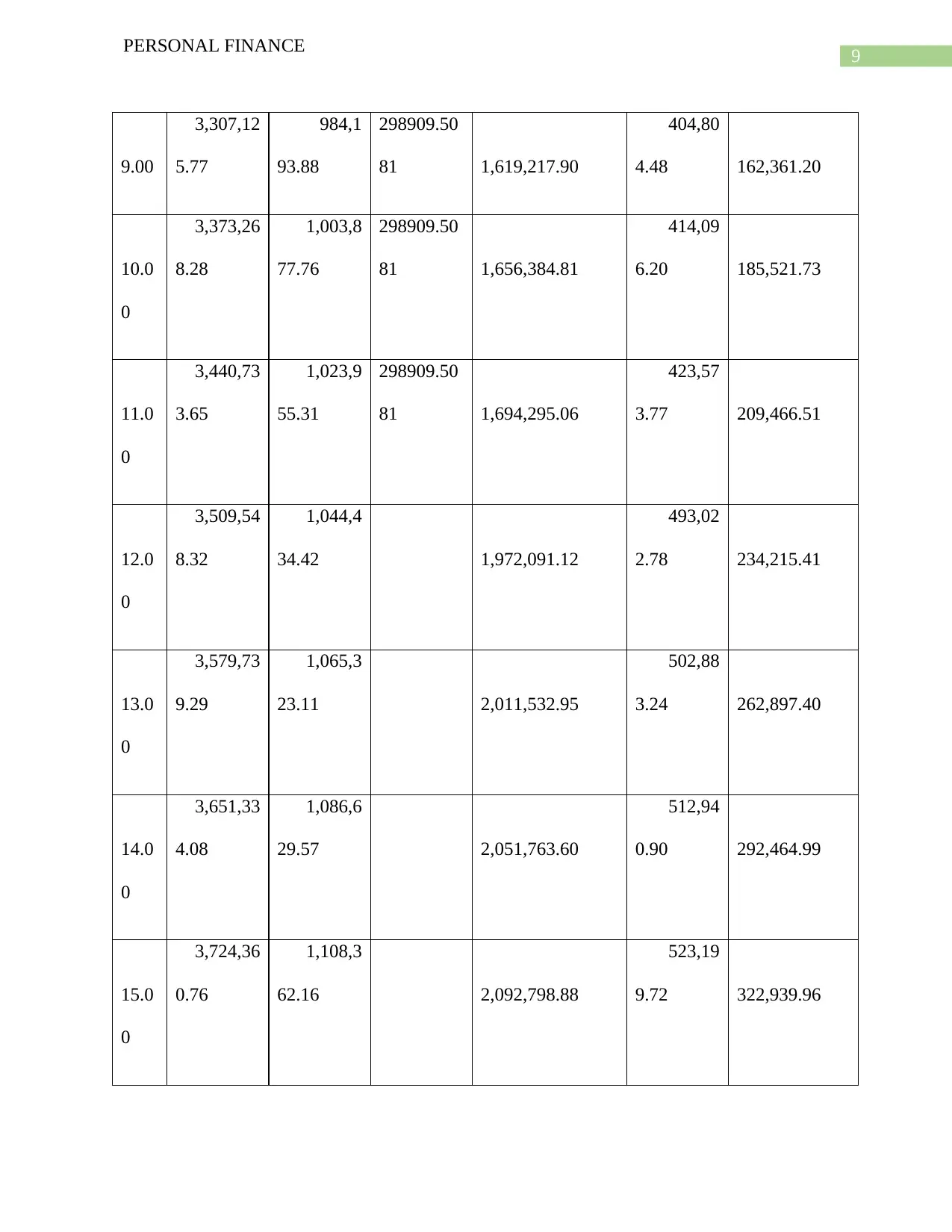
9
PERSONAL FINANCE
9.00
3,307,12
5.77
984,1
93.88
298909.50
81 1,619,217.90
404,80
4.48 162,361.20
10.0
0
3,373,26
8.28
1,003,8
77.76
298909.50
81 1,656,384.81
414,09
6.20 185,521.73
11.0
0
3,440,73
3.65
1,023,9
55.31
298909.50
81 1,694,295.06
423,57
3.77 209,466.51
12.0
0
3,509,54
8.32
1,044,4
34.42 1,972,091.12
493,02
2.78 234,215.41
13.0
0
3,579,73
9.29
1,065,3
23.11 2,011,532.95
502,88
3.24 262,897.40
14.0
0
3,651,33
4.08
1,086,6
29.57 2,051,763.60
512,94
0.90 292,464.99
15.0
0
3,724,36
0.76
1,108,3
62.16 2,092,798.88
523,19
9.72 322,939.96
PERSONAL FINANCE
9.00
3,307,12
5.77
984,1
93.88
298909.50
81 1,619,217.90
404,80
4.48 162,361.20
10.0
0
3,373,26
8.28
1,003,8
77.76
298909.50
81 1,656,384.81
414,09
6.20 185,521.73
11.0
0
3,440,73
3.65
1,023,9
55.31
298909.50
81 1,694,295.06
423,57
3.77 209,466.51
12.0
0
3,509,54
8.32
1,044,4
34.42 1,972,091.12
493,02
2.78 234,215.41
13.0
0
3,579,73
9.29
1,065,3
23.11 2,011,532.95
502,88
3.24 262,897.40
14.0
0
3,651,33
4.08
1,086,6
29.57 2,051,763.60
512,94
0.90 292,464.99
15.0
0
3,724,36
0.76
1,108,3
62.16 2,092,798.88
523,19
9.72 322,939.96
Paraphrase This Document
Need a fresh take? Get an instant paraphrase of this document with our AI Paraphraser
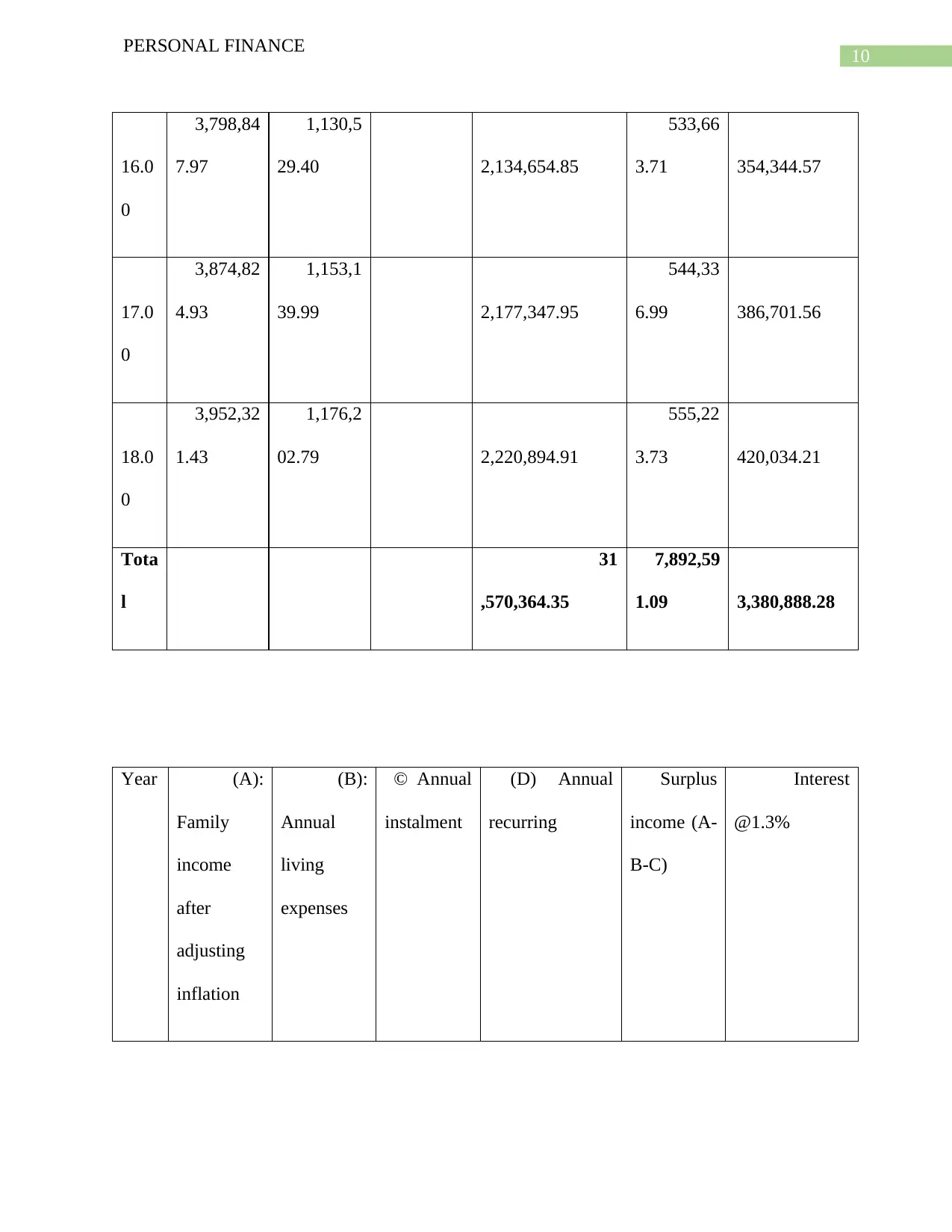
10
PERSONAL FINANCE
16.0
0
3,798,84
7.97
1,130,5
29.40 2,134,654.85
533,66
3.71 354,344.57
17.0
0
3,874,82
4.93
1,153,1
39.99 2,177,347.95
544,33
6.99 386,701.56
18.0
0
3,952,32
1.43
1,176,2
02.79 2,220,894.91
555,22
3.73 420,034.21
Tota
l
31
,570,364.35
7,892,59
1.09 3,380,888.28
Year (A):
Family
income
after
adjusting
inflation
(B):
Annual
living
expenses
© Annual
instalment
(D) Annual
recurring
Surplus
income (A-
B-C)
Interest
@1.3%
PERSONAL FINANCE
16.0
0
3,798,84
7.97
1,130,5
29.40 2,134,654.85
533,66
3.71 354,344.57
17.0
0
3,874,82
4.93
1,153,1
39.99 2,177,347.95
544,33
6.99 386,701.56
18.0
0
3,952,32
1.43
1,176,2
02.79 2,220,894.91
555,22
3.73 420,034.21
Tota
l
31
,570,364.35
7,892,59
1.09 3,380,888.28
Year (A):
Family
income
after
adjusting
inflation
(B):
Annual
living
expenses
© Annual
instalment
(D) Annual
recurring
Surplus
income (A-
B-C)
Interest
@1.3%
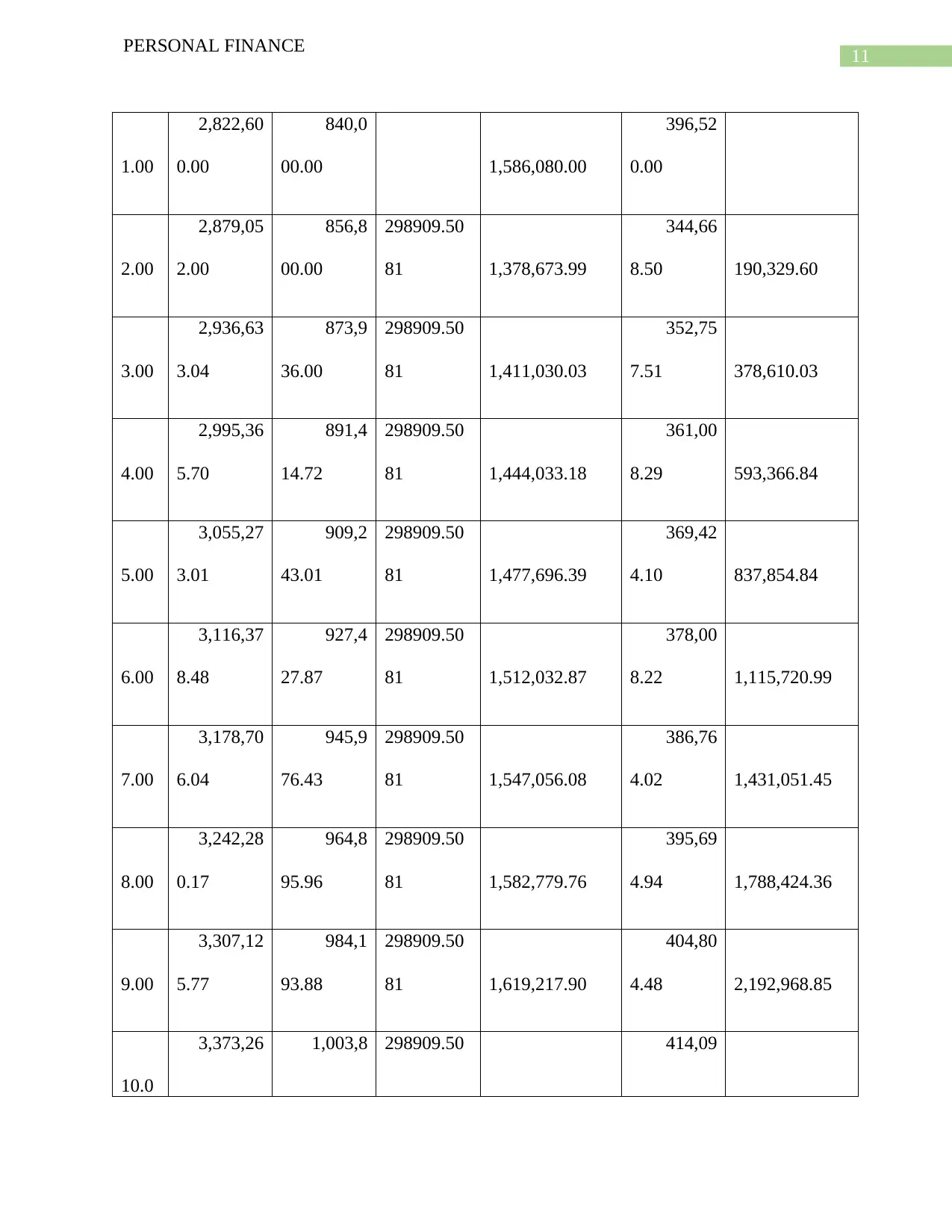
11
PERSONAL FINANCE
1.00
2,822,60
0.00
840,0
00.00 1,586,080.00
396,52
0.00
2.00
2,879,05
2.00
856,8
00.00
298909.50
81 1,378,673.99
344,66
8.50 190,329.60
3.00
2,936,63
3.04
873,9
36.00
298909.50
81 1,411,030.03
352,75
7.51 378,610.03
4.00
2,995,36
5.70
891,4
14.72
298909.50
81 1,444,033.18
361,00
8.29 593,366.84
5.00
3,055,27
3.01
909,2
43.01
298909.50
81 1,477,696.39
369,42
4.10 837,854.84
6.00
3,116,37
8.48
927,4
27.87
298909.50
81 1,512,032.87
378,00
8.22 1,115,720.99
7.00
3,178,70
6.04
945,9
76.43
298909.50
81 1,547,056.08
386,76
4.02 1,431,051.45
8.00
3,242,28
0.17
964,8
95.96
298909.50
81 1,582,779.76
395,69
4.94 1,788,424.36
9.00
3,307,12
5.77
984,1
93.88
298909.50
81 1,619,217.90
404,80
4.48 2,192,968.85
10.0
3,373,26 1,003,8 298909.50 414,09
PERSONAL FINANCE
1.00
2,822,60
0.00
840,0
00.00 1,586,080.00
396,52
0.00
2.00
2,879,05
2.00
856,8
00.00
298909.50
81 1,378,673.99
344,66
8.50 190,329.60
3.00
2,936,63
3.04
873,9
36.00
298909.50
81 1,411,030.03
352,75
7.51 378,610.03
4.00
2,995,36
5.70
891,4
14.72
298909.50
81 1,444,033.18
361,00
8.29 593,366.84
5.00
3,055,27
3.01
909,2
43.01
298909.50
81 1,477,696.39
369,42
4.10 837,854.84
6.00
3,116,37
8.48
927,4
27.87
298909.50
81 1,512,032.87
378,00
8.22 1,115,720.99
7.00
3,178,70
6.04
945,9
76.43
298909.50
81 1,547,056.08
386,76
4.02 1,431,051.45
8.00
3,242,28
0.17
964,8
95.96
298909.50
81 1,582,779.76
395,69
4.94 1,788,424.36
9.00
3,307,12
5.77
984,1
93.88
298909.50
81 1,619,217.90
404,80
4.48 2,192,968.85
10.0
3,373,26 1,003,8 298909.50 414,09
⊘ This is a preview!⊘
Do you want full access?
Subscribe today to unlock all pages.

Trusted by 1+ million students worldwide
1 out of 17
Related Documents
Your All-in-One AI-Powered Toolkit for Academic Success.
+13062052269
info@desklib.com
Available 24*7 on WhatsApp / Email
![[object Object]](/_next/static/media/star-bottom.7253800d.svg)
Unlock your academic potential
Copyright © 2020–2025 A2Z Services. All Rights Reserved. Developed and managed by ZUCOL.





